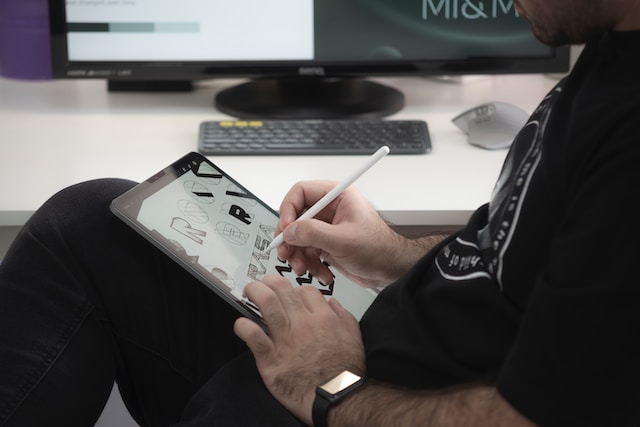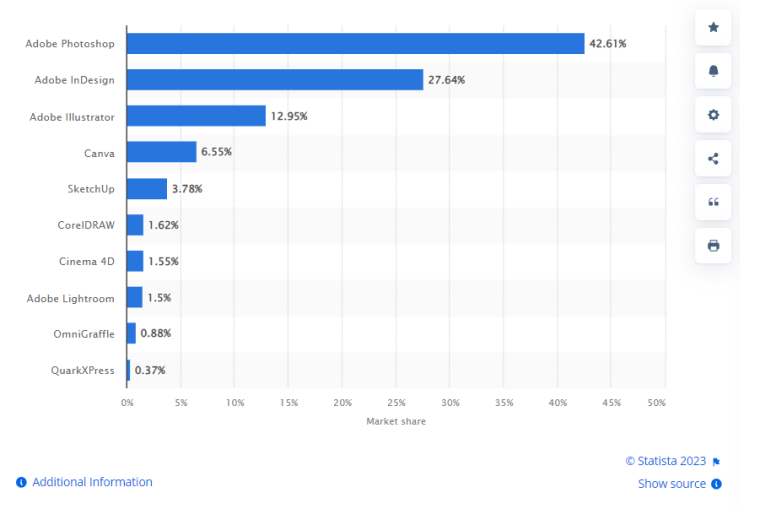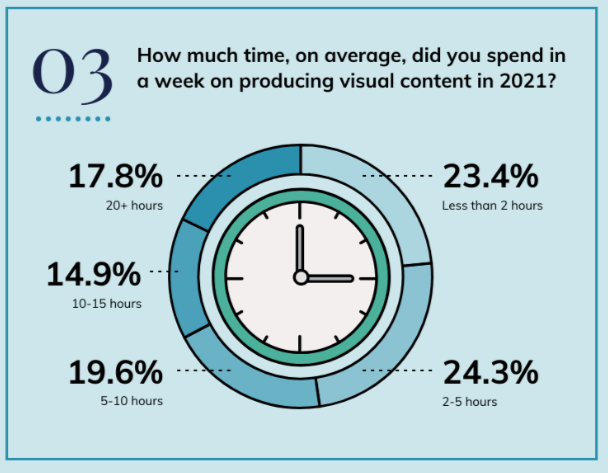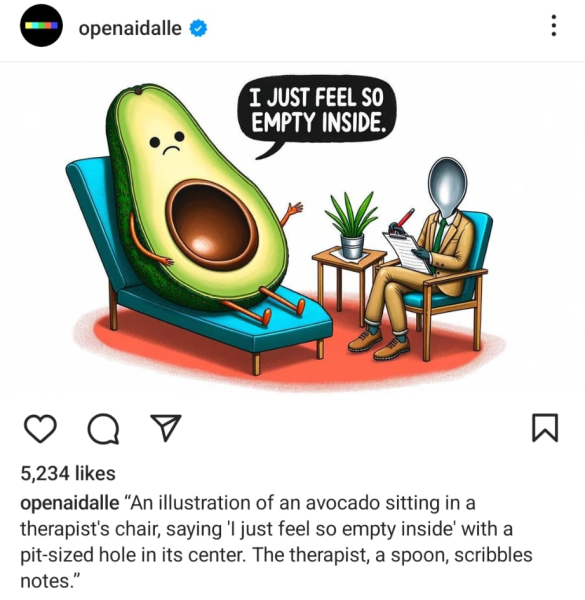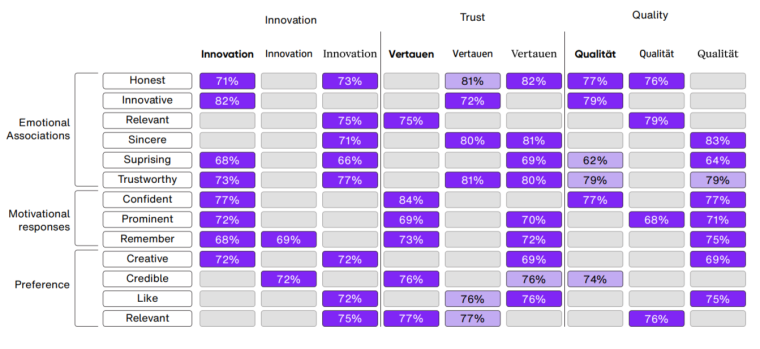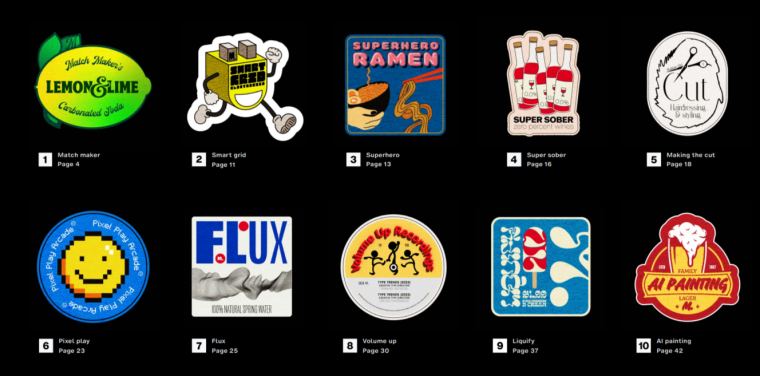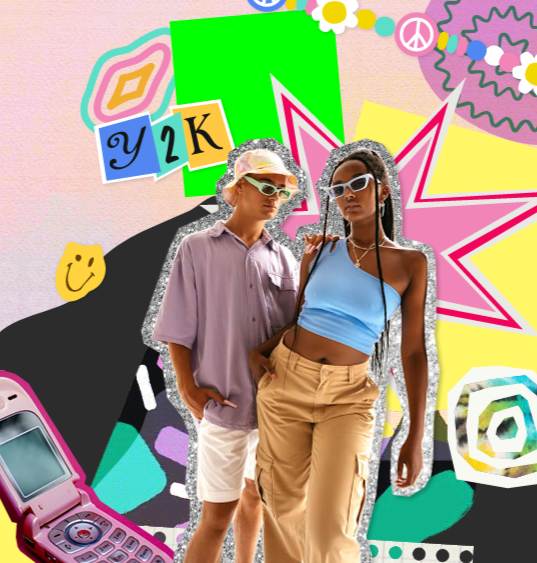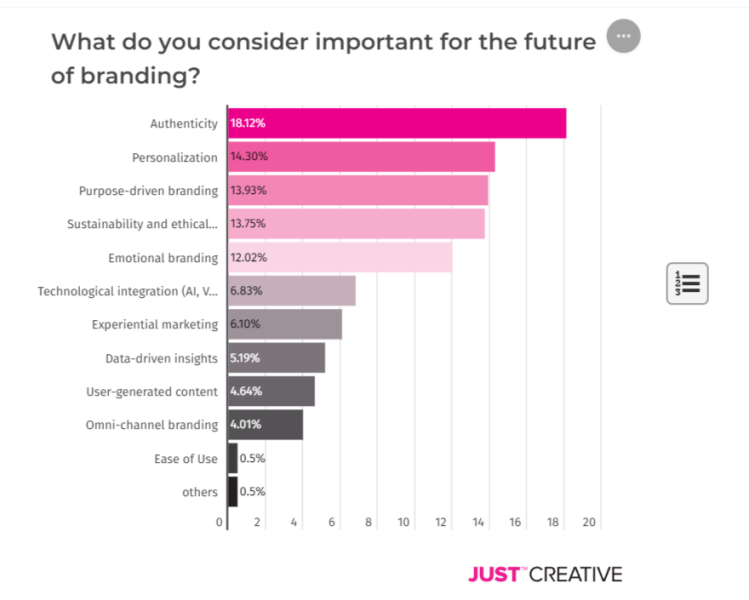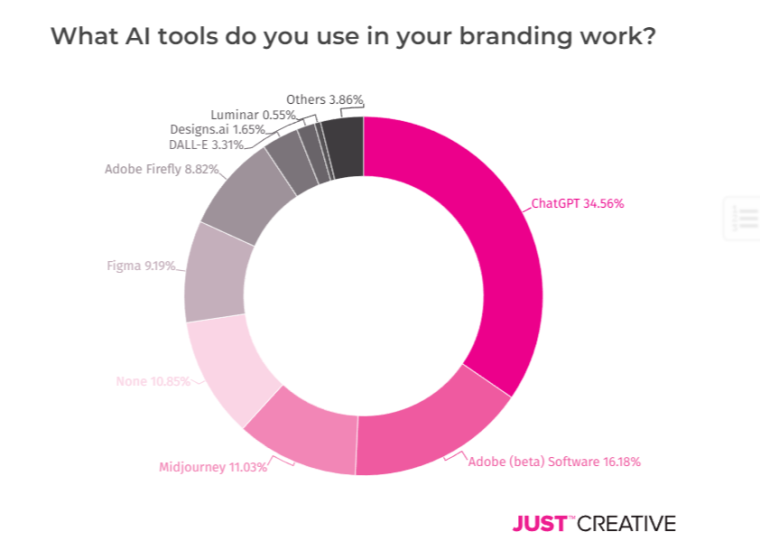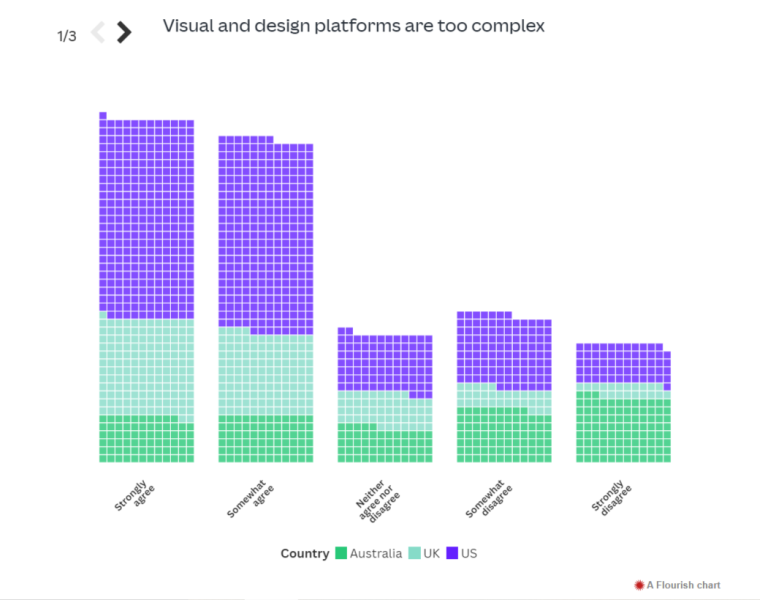A strong brand almost instantly makes people think of its colors, logo, and style. As a key aspect of branding, graphic design trends help develop brand identity and connect with customers on a deeper level.
Especially with the emergence of artificial intelligence, the graphic design scene is changing. Yet, the human touch and authenticity remain as important as ever. At Business2Community, we’ve gathered industry research reports and articles to provide a curated list of statistics, expert insights, and graphic design trends in 2025.
Freelance marketplace platform Upwork identified graphic design as the most in-demand creative skill for 2023. With a market size of $16.6 billion, the graphic design industry is booming with new design tools, AI technologies, and trends. In 2023, Adobe products led the graphic design market, with Adobe Photoshop, InDesign, and Illustrator ranking as the top three tools that dominate the market. Canva, SketchUp, CorelDRAW, Cinema 4D, Adobe Lightroom, OmniGraffle, and QuarkXPress had the next biggest shares in the market, respectively. A survey by the branding agency JUST Creative also reported that Adobe Creative Suite was the most popular design tool. According to the survey, 90% of branding professionals used Adobe tools. Besides Adobe, the other preferred tools were: In graphic design, artificial intelligence refers to the use of generative AI or AI-assisted design or text-to-image tools such as Adobe Firefly, DALL-E 2, and Runway. “If late 2022 was defined by the emergence of AI in art and design, I think we’re really on the edge of a design tool nirvana,” said Nick Hill of Re Design. Hill also stated that AI-assisted tools have made it possible for tasks that used to take hours to be completed in just a matter of minutes. In 2021, over 17% of graphic designers spent more than 20 hours per week producing visual content, while 14.9% spent between 10 and 15 hours, and 19.6% spent between 5 and 10 hours. Branding industry professionals also embraced AI in 2023. In JUST Creative’s survey, 70.4% of respondents said they wanted to work with AI tools like ChatGPT, Adobe, and Midjourney. Thanks to these tools, designers can automate repetitive tasks, streamline their work, and generate ideas. In addition to saving time and automating tasks, AI can help with creative tasks such as image generation. Below is an image created by the AI image generator DALL-E 3, based on a text-based prompt. DALLE-3 is able to generate not only images but also words. With the advent of social media, the demand for visual content increased. As a result, design literacy has become an important skill in the job market. And not only for graphic designers. In fact, 61% of non-design roles require applicants to have various design skills, such as creating graphics, GIFs, and presentations. Hybrid or remote teams also benefit from design literacy skills. In Canva’s Visual Economy Report, 90% of global business leaders said that they use digital whiteboards at least once a week. In addition to this, 89% think that visual communication helps connect remote teams and 85% said that they carry more authority than other communication methods. Using design tools and improving employees’ design literacy help companies save money and increase productivity. The design software company Canva commissioned Forrester to analyze how teams benefit from Canva for Teams, Canva’s visual collaboration work suite. The study found that Canva for Teams has helped companies boost ROI by 438%, realize benefits of $1.7 million over three years, and increase employee productivity by 26%. Font technology company Monotype partnered with the applied neuroscience company Neurons to understand how fonts drive emotions. As a part of the study, respondents were shown some classical brand values, such as innovation, trust, and quality, written in different fonts. The font type affected how people felt about the brand value, suggesting that different fonts changed the way people trusted, liked, and remembered the brand. In its annual Type Trends report, Monotype analyzed upcoming graphic design fonts in 2023. According to the report, here are some key styles for letters and fonts: Here is a visual illustration of the top 10 trending graphics and fonts according to Monotype’s report: Pantone’s pick of top ten colors for 2024 reflected feelings of nostalgia, positivity, and innovation. “Colors for NYFW Spring 2024 introduce a new interpretation of current times as memories of the past and a glimpse of the future bring hope for the present,” said Leatrice Eiseman, Executive Director of Pantone. For graphic design and creative color trends, Adobe conducted research using its global network as well as internal and external data. Here are the resulting trends: “3D OOH (out-of-home) billboards offer hyper-realistic and immersive brand experiences, blurring the lines between technology and reality,” said Holly Karlsson, creative director of Bulletproof. She also pointed out that designers should embrace evolving mediums such as Al image generation and machine learning. As an example, Karlsson pointed out the works of Refik Anadol, who has been creating AI art since 2016. “I’m never inspired by the idea of mimicking reality,” said Anadol in an interview with the architecture and design magazine Deezen. “Like, if AI can do realistic things, it doesn’t inspire me to be honest.” Dear friends, This acquisition marks a grand milestone in our studio’s journey and also for digital art. It inscribes a historic chapter as… pic.twitter.com/OyXjHP7DJt — Refik Anadol (@refikanadol) October 11, 2023 Y2K stands for Year 2000. The hashtag #y2kfashion has seen over 2.4B views on TikTok. Besides the 2000s, 60s, 70s, 80s, and 90s colors and geometric shapes have also been trending among designers. Retrofuturism was another trend that brought retro designs and technological advancements together. “Web3, AI-generated and 3D art have also lent to nostalgia-driven typefaces, dynamic retro color swatches, and the ability to honor previous modes of graphic production with seeming authenticity and ease,” said Andenew Ayele, associate creative director at ThoughtMatter, about retrofuturism. Canva’s 2023 Design Trends Forecast identified expressive 3D designs as a trend that pushes the limits of traditional graphic design. In the image below, the words “create” and “joy” use 3D fonts while the rest of the text is written in a 2D font. “Has 3D modeling and animation become graphic design?” asked Monotype’s 2023 Type Trends report. According to the report, the rise of 3D modeling could be due to the fact that graphic designers have access to better tools and more advanced technical skills compared to previous decades. Mastering 3D techniques and adding volume to designs are especially important for emerging technologies such as augmented reality (AR) and virtual reality (VR). According to Canva, pastel maximalism featuring vibrant color palettes, layered images, and blurred gradients is one of the trends of 2025. The image below features the same text as the 3D example above with a pastel maximalist style. Katie Klencheski, founder and creative director of SMAKK, thinks that the shift from Millennials to Gen Z has had an effect on this trend. “Millennials were all about minimalism, but the design trends that define Gen Z are pure chaos theory meets maximalism,” she said. “The invention of the digital camera meant more people could take photos, but it didn’t replace the need for professional photographers,” said Ashley Still, Adobe’s senior vice president of digital media when she was asked if AI will replace graphic designers. According to Still, AI will take over some routine tasks, such as creating different file formats for an image. As for generative AI, companies will still need designers to guide AI as they know how to create the right prompts. “Designers will always get better results using image generation than your average Joe because they understand how to construct an idea, even if it’s through text prompts,” added Still. With the rise of AI in design, authenticity will set designers apart. In JUST Creative’s branding survey, 74% of respondents considered authenticity to be the most important factor in the future of branding. In his interview with Deezen, new media artist Refik Anadol highlighted the importance of emotions. “A deep understanding of humanity is way more complex than any algorithm. I don’t believe in reducing this to a bunch of algorithms or papers,” he said. While AI won’t replace graphic designers, it will change the way they work. “AI is an obvious threat to many industries, including the creative sector – embrace the tools or get left behind is my philosophy,” are the words of a JUST Design survey respondent. Besides generative AI tools like ChatGPT, branding professionals used many AI design tools, including Adobe, Midjourney, and Figma. Graphic design tools affect employees working outside the design industry since non-design employees also need to have design-related tasks. For example, in major companies like LEGO, TikTok, and Amazon, design skills are required for non-design roles. Canva’s Visual Economy Report 2023 stated that there was a 104% increase in the number of people listing Canva as a skill on their LinkedIn profiles in the 12 months to April 2023. However, more than half of business leaders in Canva’s Visual Economy Report stated that they find their company’s visual design platforms too complex. Given the importance of design in non-design roles, AI and user-friendly design tools will become more and more prevalent. While technology makes designers’ jobs easier, 38.6% of branding professionals are concerned that they might challenge traditional design services, requiring designers to continuously upgrade their services and skills. Besides AI, AR and VR will continue making their way to graphic design as well. According to Tamara McLean, a UW–Madison instructor and graphic design graduate student, AR is the future of graphic design. In 2023, McLean proposed a four-week summer course to introduce AR to graphic design students. Her course covers the history and best practices of AR experiences for mobile devices. McLean’s 2023 work “Landed” brings together AR and graphic design:Key Graphic Design Trends
What are 2025’s Graphic Design Trends?
1. Top Graphic Design Tools
2. AI in Design
3. Design Literacy
4. Font Trends for 2025
5. Palette Trends for 2023
6. Hyper-reality
I’m deeply honored to announce that our artwork Unsupervised has been acquired by MoMA and is now in the museum’s permanent collection!7. Y2K Design and Retro
8. 3D Design
9. Maximalism
The Future of Graphic Design
AI Will Not Replace Designers
Authenticity Will Be Even More Important
AI-Powered Tools and Design Tools Will Increase
Digital Transformation Will Continue
What is the future of design in 2025?
Is graphic design still relevant in 2025?
Where will graphic design be in 10 years?
